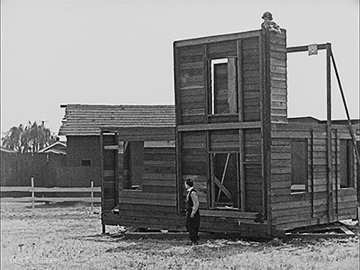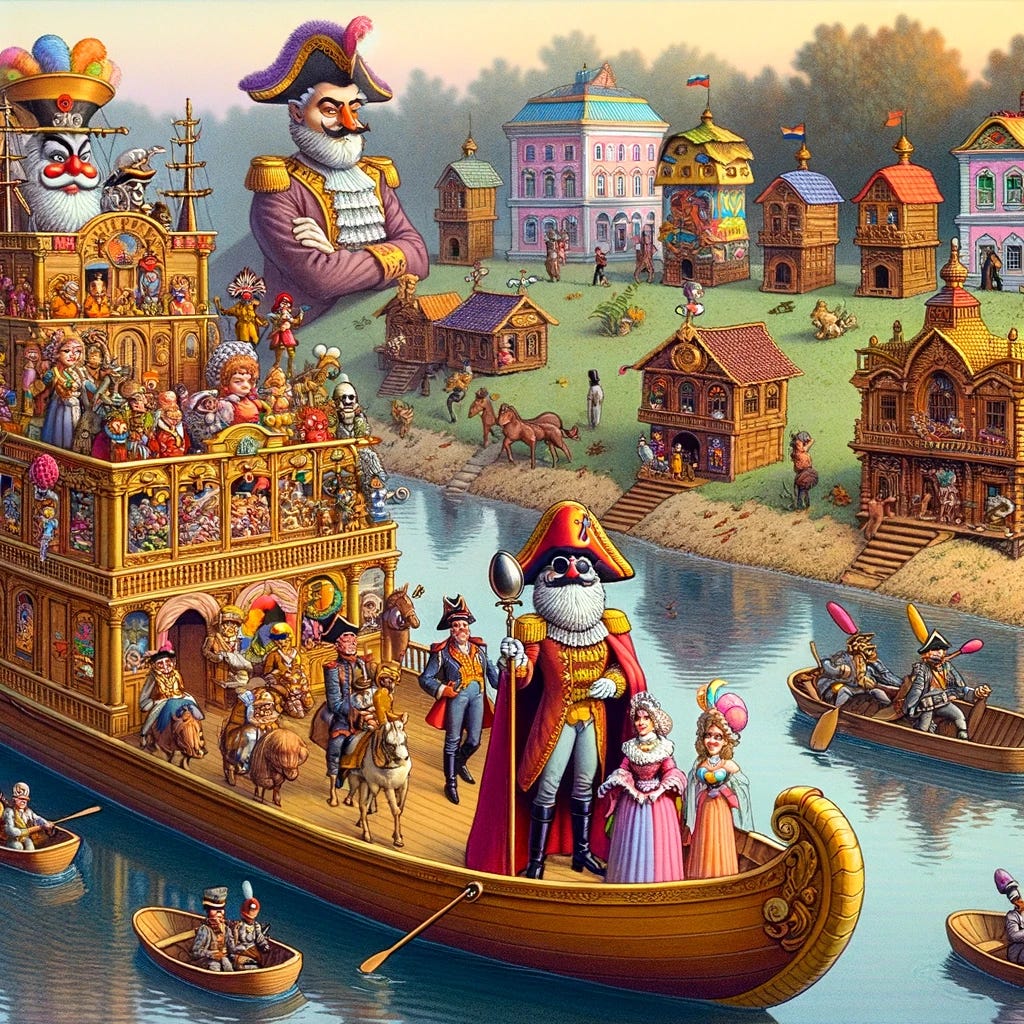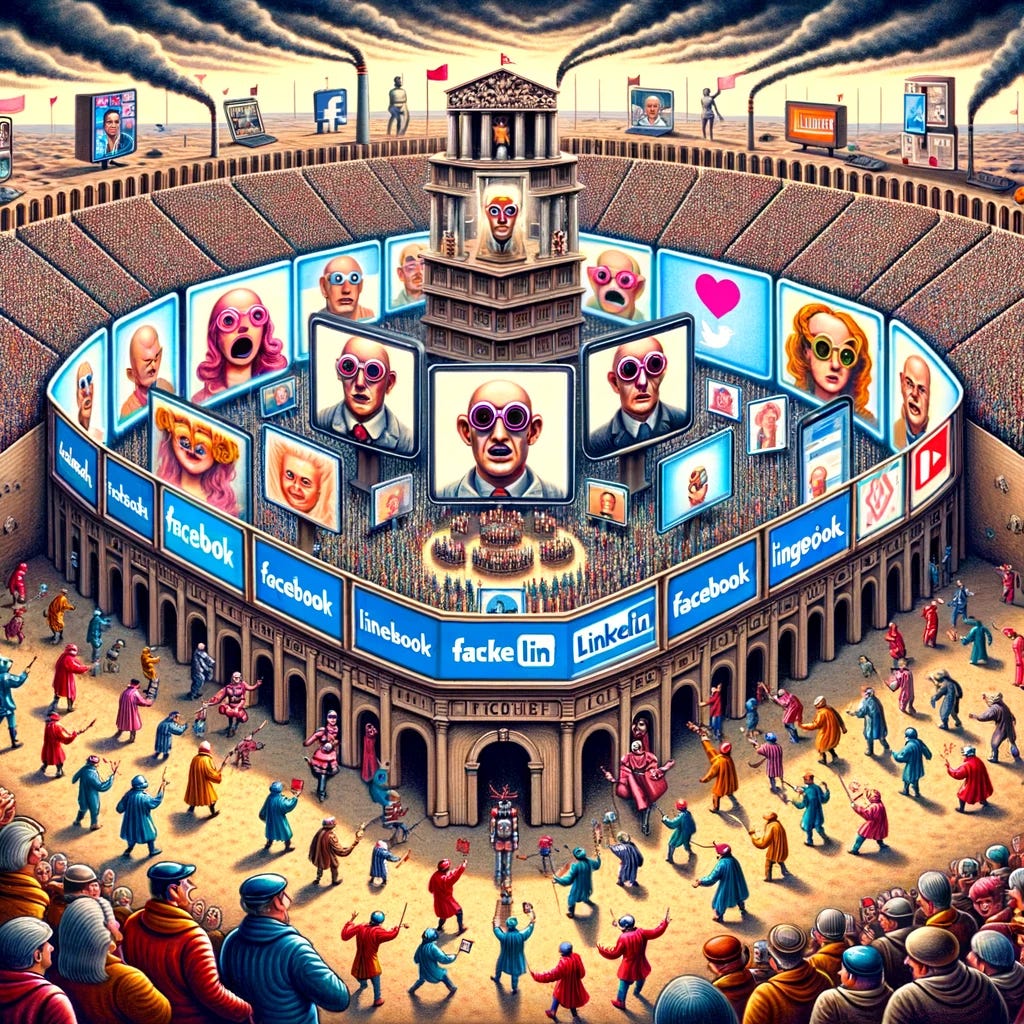"All the world's a stage, and all the men and women merely players.” - William Shakespeare
A “false front” is where the front of a building extends upwards beyond the roof, with nothing really situated behind it.
The adventurous businessmen of the Old West knew there was a good chance their newly built towns wouldn’t last too long, so they scrimped on spending.
They also wanted to impress those opulent tourists who came sauntering through town too — thus, the false-but-pretty and useless front.
We probably know them more from Westerns—those Earthbound versions of Star Wars—where you’d see gunmen falling humorously off rickety tall wooden walls overtop the saloon or the House of the Rising Gun.
Not just because of historical accuracy — the filmmakers also needed cheap temporary buildings to use in front of the cameras. Yet, we, the movie goers, just as the tourists, still marvel at the grandioseness of the set.
But pull back the veil and it all comes crashing down.
My hometown in Canada had these beautiful unoccupied brick houses in most neighborhoods. If you snuck around back, as a kid is wont to do, you’d hear the reason why.
They were some sort of electricity transmission power stations.
I didn’t know exactly what they were as a kid. I clearly still don’t, other than that they, too, were a false front meant to keep local housing prices unaffected.
When I visited Cuba, where my book haters must surely assume I was indoctrinated, I marveled at the towns driving through on my rented scooter.
Their false fronts were painted in the widest variety of loud, clashing, ugliest damn painted walls you ever could see.
Lemon zest with a hint of rebellion. Flamingo caught in toast. Blue. Yuck. The only universal quality among them was the specks of paint slowly chipping off revealing the communisticky constructed concrete beneath.
It took me a bit of time to figure out what these were, especially as I came to see them time and time again in my travels.
Turns out, the government had these false fronts painted for little ol’ me—the gullible tourist.
Although in this particular case, I’m sure the jefe behind that idea was, perhaps, colorblind, +- the color.
And it’s this last one that got me thinking.
While the other false fronts often had a basic purpose — be it saving money, saving beauty, or saving disappointment — there is another kind of false front.
The kind meant to deceive for not-so-nice purposes.
These are called a “Potemkin village.”
And I hate them.
What is a Potemkin Village?
The disputed story behind the phrase is almost amusing, if it wasn’t so reminiscent.
Catherine the Great was due to visit her newest territory of Crimea after Russia annexed it in 1783 (sound familiar?). She had a minister and possible lover that went by the name of Grigory Potemkin who was now in charge of the war-torn region.
As a new great war approached the Russian empire of the time, the Empress decided to visit the frontline territories with a select few foreign ambassadors.
She feasibly wanted to drum up a good impression to help garner their support (and money and soldiers and weapons) for the battles to come.
In Catherine and Potemkin’s minds, that required putting on a show.
As the Empress and her entourage toured into Crimea on a large slow-moving barge down the Dnieper River, Potemkin allegedly had a series of fanciful villages set up and occupied by his troops to put on a false front of newfound prosperity.
The amusing part of the story alleges that these villages were then dismantled and rebuilt in a different order, over and over again as the barge drifted slowly down the river.
Frugal, crafty, and impressive — a triple win straight out of an 80s cartoon, if true.
But whether or not the story is actually real is another matter. Because in the modern age, I can’t help but see Potemkin villages everywhere I look.
We’re Living in a Potemkin Village
The examples stretch far and wide.
Just think about the definition — an impressive facade or show designed to hide an undesirable fact or condition— and you can imagine the possibilities.
The stage is set every New Year's Eve, where grand declarations of hitting the gym echo into the night, only to be forgotten as quickly as the resolutions were made.
The gym waits, empty and hopeful, but our couches win the day in the end.
Flash to Instagram, where a thousand clicks boil down to a single, polished snapshot. Here, everyone's life is an endless parade of perfect moments, a tropical vacation that never ends.
But behind the screen?
Just ordinary days, ordinary midriffs, and ordinary highs and lows of life, minus the glamour filter.
Cut to the '50% Off Store', a permanent fixture in the retail world. Prices slashed forever on a discount that never really was.
It's a perpetual sale, a bargain in name only. So Potemkiny.
Zoom in on 1982. Donald Trump, before his days in the Oval Office, stages a construction site. Bulldozers push dirt aimlessly, all to create the illusion of progress, convincing investors to buy into his casino dream.
Fast forward, and his presidency plays out like a sequel, grand statements with little foundation and 30,573 reasons to not vote for him ever again.
But it's a script followed by many in the political theater, where Ex-Twitter becomes the stage for grand gestures and hollow promises.
A politician blames windmills for a crisis, then escapes to warmer climes while his state freezes. Another makes bold claims on social media, only to contradict them in action. Anti-this or anti-that politicians get elected on their platforms, get accepted into the ultra-lucrative game of favors from führers, and their morals vanish from existence.
A tech giant testifies before Congress, the company's polished exterior promotes only ‘benefits for society’ while sucking at the teat of our collective fortunes behind closed doors. Celebrities preach environmental conservation, then jet off in private planes. Major corporations tout diversity, yet their boardrooms tell a different story.
With a $5,000 rejuvenated wink and a $17,000 facelifted grin, they tell us tourists of life exactly what we want to hear, time and time again.
But remove the false front, and what do they mean?
“Believe what I say, and not what I do.”
The Grand Illusion of Anti-Social Media
Everywhere you turn, especially in the digital colosseum we call the internet, Potemkin villages abound.
Have we forgot what a penguin is? Even if it waddles, squawks, and behaves like a corrupt POS penguin who no one knows how it got elected in the first place?
Or perhaps we have a collective case of ignorance, where the only sane person in a room full of whackos finally starts wondering who the real lunatic is.
Our online existence, “social media”, a mirage we can't seem to escape, is built on a foundation of half-truths and doctored realities.
Facebook 'friends'? Friendly strangers.
Those LinkedIn connections? More distant than the stars in the night sky.
The daily newsfeed? An algorithmic cocktail of facts and fiction, served with a twist of induced rage.
And the culprits?
It's easy to point fingers.
Media moguls with their empires of influence, spinning tales that fit their agendas. TV pundits stirring the pot, cooking up controversies for ratings, even at the cost of common sense and collective cohesion.
But what about us, the everyday people?
We’ve ever so slowly—but willingly—checked into this grand illusion.
In the beginning, Potemkin Village was just a dingy motel by the roadside, occupied by shifty advertisers, dreamy tech-inventors, and smooth-talking politicians.
But we saw something else — a shimmering mirage of convenience, connection, and a chance to share our accomplishments with those we cared about and those we wanted to impress.
So, we moved in, one by one, then in droves.
Now, trapped in this illusion of our own making, we find it's not so easy to check out. We're in Hotel California, humming along to a tune that's become our reality.
In this world of make-believe-real-life, we've unwittingly become both the audience and the performers. We've donned the rose-colored glasses, blurring the lines between what's real and what's just a well-crafted show.
As they say, if a service is free, you are the product.
And after all these years of social mediaizing ourselves to death, it’s not the temporary villages by the side of the river or the ugly colors of the Cuban houses that are Potemkin’s vision—it’s us.
We’ve settled so far up our own asspirations we can’t tell a false front from a penguin suited duck.
Potemkin Village, once a metaphor for deception, is now our zip code. We've settled in, decorated the place, and hung up our hats.
A wonderful bustling village full of beautiful people, golden yachts, and gorgeous, but oh-so realistically achievable (of course!) lives.
Yet, completely and utterly devoid of truth.
Welcome, dear friends, to the promised age of the future:
Welcome to Potemkin Village
Population: Us
Written by a ranty J.J. Pryor
👋Click the heart thingy? The algorithm loves it. I love it more.👋
*All images made with DALL-E 3.










There was an episode of "Rocky and Bullwinkle" I remember where Boris and Natasha had jury-rigged a small American town with false fronts so it would appear to be Washington, D.C. as a means of fooling our heroes. That was done, but not before it appeared the citizens of the town were starting to buy into the fact that maybe it really was Washington.
My point being: this is where media literacy is so important. Like the media, Potemkin Villages are illusions created to advance sometimes nefarious means. And the sooner that people can be educated about them, the better.
That was certainly thought provoking. Life was certainly a lot more honest before social media, but the false have always been with us. Just used to be a lot easier to spot. I worry for the next generation and a happy to be retired.